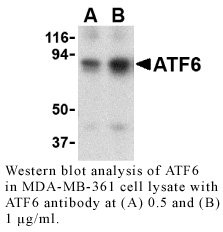Anti-Human Activating Transcription Factor 6 (NT) (ATF6)
Data
- -
- -
Antibody DetailsProduct DetailsReactive Species Human Host Species Rabbit Immunogen PN:A276 Product Concentration 0.5 mg/ml Formulation This polyclonal antibody is formulated in phosphate buffered saline (PBS) pH 7.4 containing 0.02% sodium azide as a preservative. Storage and Handling This polyclonal antibody is stable for at least one week when stored at 2-8°C. For long term storage, aliquot in working volumes without diluting and store at –20°C in a manual defrost freezer. Avoid Repeated Freeze Thaw Cycles. Country of Origin USA Shipping Next Day Ambient RRIDAB_2828084 Each investigator should determine their own optimal working dilution for specific applications. See directions on lot specific datasheets, as information may periodically change. DescriptionDescriptionSpecificity Rabbit Anti-Human Activating Transcription Factor 6 (ATF6) recognizes an epitope near the N-terminus of Human and Mouse ATF6. This polyclonal antibody was purified using affinity chromatography. Background Disruptions of protein folding and maturation in the endoplasmic reticulum (ER) result in the activation of the unfolded protein response (UPR), an integrated cellular signaling pathway that transmits information from the ER lumen to the cytoplasm and nucleus. Activating transcription factor 6 (ATF6) as well as the ER-transmembrane protein kinases IRE1p and PERK are the major transducers of the UPR . ATF6 is an ER transmembrane protein that is normally bound to the ER chaperone GRP78, but upon ER stress is released from GRP78 and proteolytically cleaved to yield a cytosolic fragment which then migrates to the nucleus, and together with the transcription factor XBP-1, activates transcription of UPR-responsive genes.2-4 ATF6 has two isoforms (ATF6α and ATF6β); only ATF6α is recognized by this antibody. PubMed References & Citations1. Liu, CY. et al. (2003) J Cell Sci. 116(Pt 10):1861-2. 2. Haze, K. et al. (1999) Mol. Cell. Biol. 10:3787 3. Little, E. et al. (1994) Crit. Rev. Eukaryot. Gene Expr. 4:1 4. Yoshida, H. et al. (2001) Cell 107:881 Technical ProtocolsCertificate of Analysis |
Related Products
- -
- -



